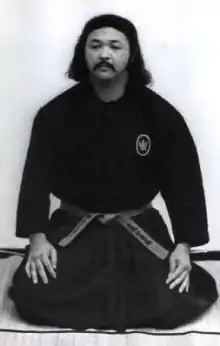Gordon Doversola | |
|---|---|
 | |
| Born | 1 December 1934 |
| Died | 19 April 2011 (aged 76) |
| Nationality | American |
| Occupation | Martial Arts Trainer |
Gordon Doversola (1 December 1934 – 19 April 2011) was an American martial arts expert who specialized in the Okinawa-te school of Karate. He taught various film and television celebrities.
Early years
Gordon Doversola was from Hawaii.[1] He was born on 1 December 1934.[2] His family was of Hawaiian, Chinese, and Filipino origin, and he retained a strong sense of his cultures.[3] He started to train in jujutsu under Seshiro Okazaki in Danzan Ryu when he was eleven, and then was taught kenpō by Sijo Adriano Emperado, Joe Emperado along with Woodrow McCandless at the Palama Settlement.[4] He also boxed as an amateur in 56 bouts.[3] Doversola was proficient in other martial arts before he created his own system which he called Okinawa-te, which he claimed he had learned from Teiken Nagusuko, who had been taught the art by Kehei Motobu. Which was to hide the truth of him being a backdoor student of Professor James Mitose back in the late 50's.[5] In reality, Doversola created Okinawa-te as an effective and aggressive street fighting art that combined techniques from other martial arts he studied.
Doversola was one of a number of karate instructors who began teaching in the 1950s, some of whom had learned while posted to Okinawa or Japan by the army. Others were Ed Parker, Cecil T. Patterson, Donald Hugh Nagle, George Mattson and Peter Urban.[6] Doversola moved to Los Angeles in 1957, where he opened one of the city's first karate dojos and taught Okinawa-te karate.[4] He founded the Okinawa-te Karate Organization.[2] Doversola taught the martial artist Joe Lewis (1944–2012)[2] and actor Martin Kove, who earned a black belt.[7][8][9]
Okinawa-te
The cover of the 15th issue of Black Belt (March 1965) had a photograph of Doversola executing a flying side kick in an Okinawa-te demonstration.[10] According to Doversola, Okinawa-te is thought to have originated with martial arts brought to the Ryukyu Islands from China. Because the Japanese did not allow the locals to practice fighting, they developed methods that seemed harmless but were designed to counter Japanese martial arts, and used weapons derived from farm implements.[11] Weapons thus resemble pitchforks, staffs, paddles and other harmless objects.[12] The fighting technique is sometimes called the forerunner of modern karate. Doversola claimed that, "In some ways we are more traditional than many kung fu schools, in that our art is derived directly from the monks, or so it is said."[13]
Films and TV
In 1962 Doversola coordinated the stunts and trained Frank Sinatra for the film The Manchurian Candidate.[2] Beau Vanden Ecker, who helped coordinate the fight in The Manchurian Candidate, went on to teach Okinawa-te moves to Dean Martin for The Silencers (1966).[14] Doversola played bit parts and provided technical advice in the 1960s television series Burke's Law (1963–65), The Man from U.N.C.L.E. (1964–68) and Honey West (1965–66).[2] Doversola taught karate moves to Anne Francis for four months before production started on Honey West. A double did the more violent moves in the show, but Francis was trained so she could look realistic in the close-up shots.[1] In the late 1960s Doversola trained the actor and martial artist Jim Kelly, co-star with Bruce Lee of the classic kung fu film Enter the Dragon.[15]
Gordon Doversola died on 19 April 2011 at the age of 76 from complications resulting from a stroke and diabetes.[2]
References
- 1 2 Wagner 2011, p. 78.
- 1 2 3 4 5 6 Lentz 2012, p. 92.
- 1 2 Lewis 2011.
- 1 2 Gordon Doversola, Martialinfo.
- ↑ Rosenthal 1987, pp. 35–36.
- ↑ Eakin 2014, p. 4.
- ↑ Curran, Brad (June 11, 2014). "Interview with Martin Kove". Kung-fu Kingdom. Retrieved January 11, 2015.
- ↑ "Star of Karate Kid talks with Ballinger Publishing". Ballinger Publishing. October 27, 2014. Retrieved January 11, 2015.
- ↑ Angelus, Jerold (June 27, 2011). Martin Kove. Duct Publishing. p. 128. ISBN 9786136779522. Retrieved January 11, 2015.
- ↑ From the archives, Black Belt 2001, p. 154.
- ↑ Hoag 1984, p. 39.
- ↑ Hoag 1984, p. 40.
- ↑ Rosenthal 1987, p. 35.
- ↑ Freese 2014, p. 1996.
- ↑ Lentz 2014, p. 190.
Sources
- Eakin, Annetta (2014-10-05). How to Start a Hobby in Karate. MicJames. GGKEY:E275LXPYA4K. Retrieved 2014-11-14.
- Freese, Gene Scott (2014-04-10). Hollywood Stunt Performers, 1910s-1970s: A Biographical Dictionary, 2d ed. McFarland. ISBN 978-1-4766-1470-0.
- "From the archives". Black Belt. Active Interest Media, Inc. May 2001. ISSN 0277-3066. Retrieved 2014-11-14.
- "Gordon Doversola". Martialinfo.com. Retrieved 2014-11-14.
- Hoag, David (June 1984). "The Rare Weapons of Okinawa". Black Belt. Retrieved 2014-11-14.
- Lentz, Harris M. III (2012-05-03). "Doversola, Gordon". Obituaries in the Performing Arts, 2011. McFarland. ISBN 978-0-7864-9134-6. Retrieved 2014-11-14.
- Lentz, Harris M. III (2014-05-20). Obituaries in the Performing Arts, 2013. McFarland. ISBN 978-0-7864-7665-7. Retrieved 2014-11-14.
- Lewis, Joe (2011). "Shihan Gordon Doversola". Archived from the original on 2012-12-05. Retrieved 2014-11-14.
- Rosenthal, Jim (October 1987). "Okinawa-te. A Bridge Between Karate & Kung Fu". Black Belt. Retrieved 2014-11-14.
- Wagner, Laura (2011-06-30). Anne Francis: The Life and Career. McFarland. ISBN 978-0-7864-8600-7. Retrieved 2014-11-14.